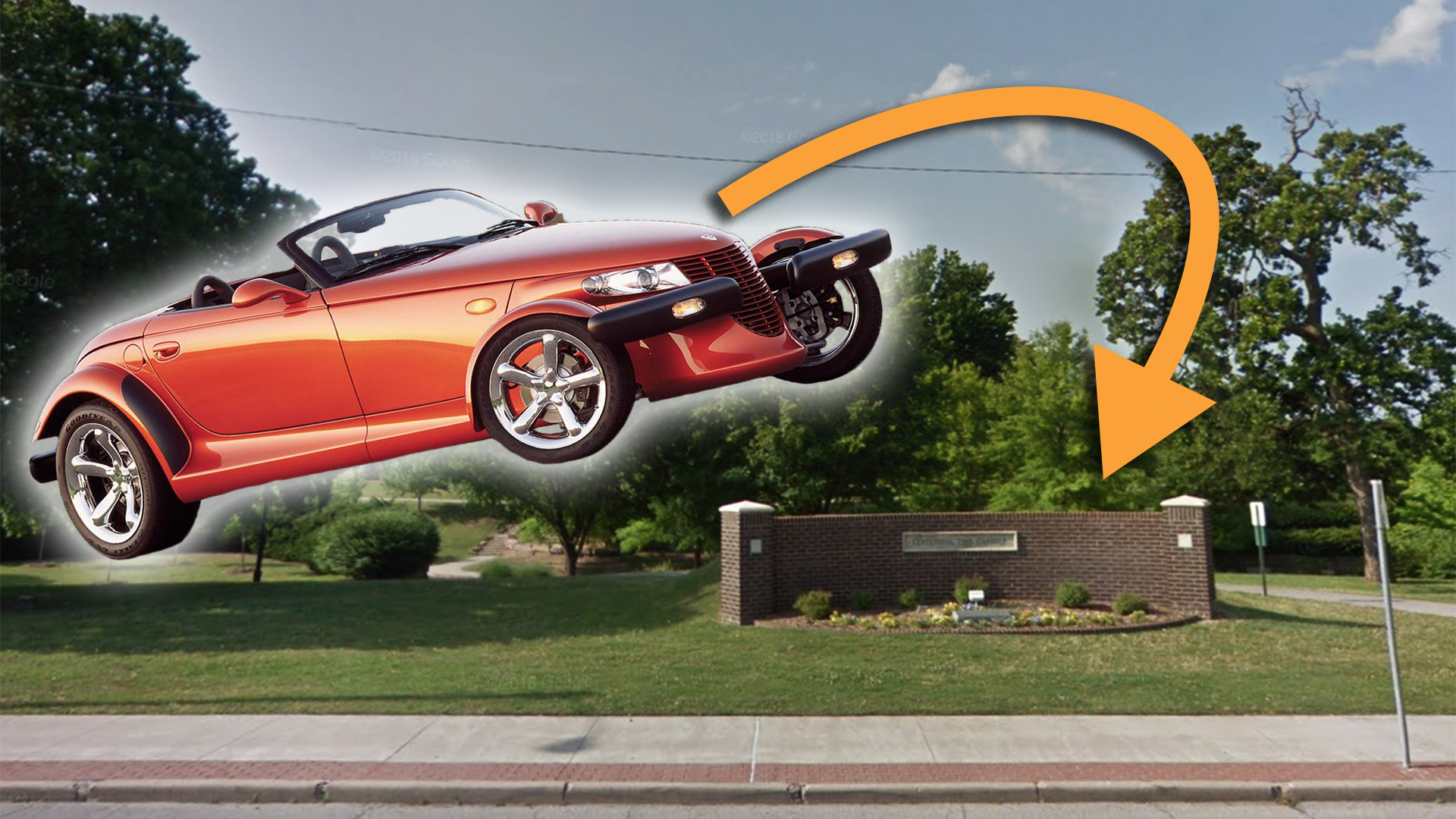

Oklahoma is a weird place—look no further than Tulsa’s propensity for burying cars in its city parks. In 1957, local officials celebrated the state’s semicentenary in by stuffing a zero-mile Plymouth Belvedere coupe in a 50-year time capsule ten feet under the courthouse lawn. It didn’t end very well when Miss Belvedere’s rotted corpse was exhumed in 2007. But back in the late Nineties, blissfully free of that knowledge, Tulsa went ahead and buried a second car to mark its 100th anniversary: a pre-production 1998 Plymouth Prowler prototype that’s still entombed in Centennial Park, where it will remain until 2048.
The 1957 Belvedere was a run-of-the-mill model donated by a local deal group, and it was no more special than the cigarettes and bobby pins with which it was buried. But automakers don’t usually pass out prototypes, so The Drive reached out to the Tulsa Historical Society and Fiat-Chrysler to get the full story of how a rare pre-pro Prowler landed in the city’s hands.




It goes like this: in the mid Nineties, as people murmured about Miss Belvedere entering her fourth decade underground in a nuke-proof concrete vault, former Chrysler executive Joe Cappy moved to Tulsa to help spin off the automaker’s rental car business as publicly-traded Dollar Thrifty. Cappy wanted to learn about the history of his new hometown, and it wasn’t long before the story of the buried car surfaced and struck his imagination.
There could be no greater demonstration of his newfound local pride than helping Tulsa celebrate its 100th with a second time capsule Plymouth. And not just any Plymouth, but its impending halo car: the Prowler. “There’s something about time capsules. It’s always fascinating,” Cappy later told a local news station.

As the former CEO of pre-merger AMC and vice president of international operations at Chrysler, Cappy was able to pull a few strings and line up one of the few fully-kitted prototypes—not the Jeep Wrangler-bodied “Prangler”—in 1997. On January 18, 1998, Tulsa committed the car to earth in a grand ceremony, along with period menus from local restaurants, a City of Tulsa Financial Report, a stack of third-graders’ essays on what they think Tulsa will look like in 50 years, Beanie Babies, and other late 20th century ephemera. Cappy himself drove it into the vault, a surface-level mausoleum that was then encased in dirt to form a small hill.
Despite liberal use of plastic wrap and cosmoline, Miss Belvedere was ruined by water seeping into the less-than-airtight concrete chamber and eventually filling it to the brim; the car spent an unknown amount of time fully submerged, possibly years. De-rusting its oxidized husk took a decade, and even then it was barely presentable. Tusla turned it away and Miss Belvedere eventually landed at a small automotive museum in northern Illinois. Not exactly the fate everyone imagined in 1957.



Fortunately, chances are good the Prowler survives in better condition. It’s sealed in a pressurized plastic box filled with argon, and because it’s mostly above grade, groundwater intrusion shouldn’t be an issue. All fluids were supplanted by synthetic stabilizers, and its primarily aluminum construction—a big advance at the time—will help safeguard against corrosion if any moisture gets in there.
On that topic, it’s interesting to note the different mindsets of each era when it came to conceptualizing the future. The 1957 Plymouth was buried with both gasoline and motor oil in the event that humanity had moved beyond fossil fuels by the time it was dug up the following century—such was the optimism of postwar America, which would flirt with a freaking jet car just a few years later. Technological progress, especially in transportation, was a wondrous inevitability.



Meanwhile, the Prowler wasn’t stashed with those reserve fluids. Despite early electric vehicle efforts from major manufacturers in the late 1990s, few were thinking about EVs as an impending reality. And if you think about it, the Prowler itself—a neoclassical hot rod looking back over half a century—is kind of a perfect representation of the way we thought certain things had locked into place that decade. You’ll still be able to get gasoline somewhere in 2048, but it’s just as likely that most of the crowd that gathers to see the car emerge that day will have never seen it, used it, or smelled it themselves.
Tulsa’s also being a little more cautious with the capsule. In 2003, it was dug out and removed from its original location to avoid construction of a new retention pond and community center. Officials resisted the urge to crack it open and reinterred it on the park’s north side along East 6th Street, where it remains today. Here’s the Google Street View link.
So how will it look in 28 years? Probably better than most of us.
Got a tip? Send us a note: tips@thedrive.com